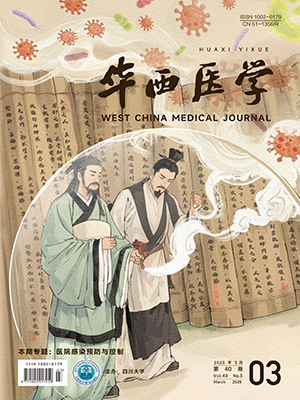| 1. |
Lamy B, Sundqvist M, Idelevich EA, et al. Bloodstream infections - standard and progress in pathogen diagnostics. Clin Microbiol Infect, 2020, 26(2): 142-150.
|
| 2. |
Goto M, Al-Hasan MN. Overall burden of bloodstream infection and nosocomial bloodstream infection in North America and Europe. Clin Microbiol Infect, 2013, 19(6): 501-509.
|
| 3. |
Pliakos EE, Andreatos N, Shehadeh F, et al. The cost-effectiveness of rapid diagnostic testing for the diagnosis of bloodstream infections with or without antimicrobial stewardship. Clin Microbiol Rev, 2018, 31(3): e00095-17.
|
| 4. |
Rhodes A, Evans LE, Alhazzani W, et al. Surviving sepsis campaign: international guidelines for management of sepsis and septic shock: 2016. Intensive Care Med, 2017, 43(3): 304-377.
|
| 5. |
梁蓓, 姜利, 刘淑梅, 等. 首都医科大学附属复兴医院 2012 年住院患者血流感染分析. 中华内科杂志, 2016, 55(8): 609-612.
|
| 6. |
张家源, 陈玉梅, 邹尧, 等. 重症血液病患儿血流感染的临床分析. 中华医院感染学杂志, 2014(20): 5136-5138.
|
| 7. |
郭鹰, 江代红, 郭富饶. 血流感染的实验室诊断技术进展. 实用医学杂志, 2021, 37(17): 2300-2303.
|
| 8. |
刘晔, 许小毛. 基于纳米孔测序技术的临床检测研究进展. 中华检验医学杂志, 2022, 45(3): 296-299.
|
| 9. |
Garner JS, Jarvis WR, Emori TG, et al. CDC definitions for nosocomial infections, 1988. Am J Infect Control, 1988, 16(3): 128-140.
|
| 10. |
Costa SP, Dias NM, Melo LDR, et al. A novel flow cytometry assay based on bacteriophage-derived proteins for Staphylococcus detection in blood. Sci Rep, 2020, 10(1): 6260.
|
| 11. |
Mehl A, Åsvold BO, Lydersen S, et al. Burden of bloodstream infection in an area of Mid-Norway 2002-2013: a prospective population-based observational study. BMC Infect Dis, 2017, 17(1): 205.
|
| 12. |
Liu V, Escobar GJ, Greene JD, et al. Hospital deaths in patients with sepsis from 2 independent cohorts. JAMA, 2014, 312(1): 90-92.
|
| 13. |
范帅华, 杜鹏程, 郭军. 纳米孔测序技术在呼吸系统感染病原学诊断中的应用价值与展望. 中华医学杂志, 2021, 101(25): 2013-2015.
|
| 14. |
Simner PJ, Miller S, Carroll KC. Understanding the promises and hurdles of metagenomic next-generation sequencing as a diagnostic tool for infectious diseases. Clin Infect Dis, 2018, 66(5): 778-788.
|
| 15. |
Opota O, Jaton K, Greub G. Microbial diagnosis of bloodstream infection: towards molecular diagnosis directly from blood. Clin Microbiol Infect, 2015, 21(4): 323-331.
|
| 16. |
王玉静, 陆梓涔, 陈俊煜, 等. 高通量测序技术的发展及其在临床检测中的应用. 厦门大学学报(自然科学版), 2021, 60(5): 811-820.
|
| 17. |
中华医学会检验医学分会临床微生物学组, 中华医学会微生物学与免疫学分会临床微生物学组, 中国医疗保健国际交流促进会临床微生物与感染分会. 宏基因组高通量测序技术应用于感染性疾病病原检测中国专家共识. 中华检验医学杂志, 2021, 44(2): 107-120.
|
| 18. |
叶福强, 李鹏, 韩一芳, 等. 基于纳米孔测序技术的呼吸道病原体快速确认. 分子诊断与治疗杂志, 2020, 12(2): 127-132, 150.
|
| 19. |
李丽, 金力, 朱咏臻, 等. 2014-2019 年某医院血流感染患者的临床特征和病原学分析. 中国抗生素杂志, 2022, 47(1): 84-89.
|
| 20. |
Wang K, Li P, Lin Y, et al. Metagenomic diagnosis for a culture-negative sample from a patient with severe pneumonia by nanopore and next-generation sequencing. Front Cell Infect Microbiol, 2020, 10: 182.
|
| 21. |
Charalampous T, Kay GL, Richardson H, et al. Nanopore metagenomics enables rapid clinical diagnosis of bacterial lower respiratory infection. Nat Biotechnol, 2019, 37(7): 783-792.
|




